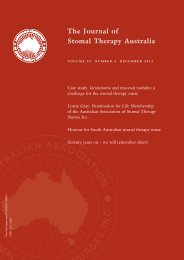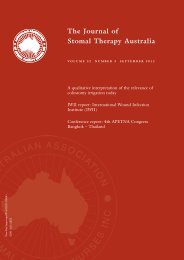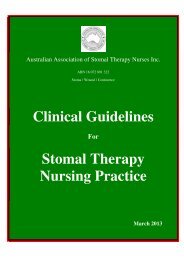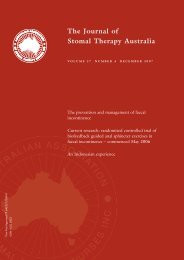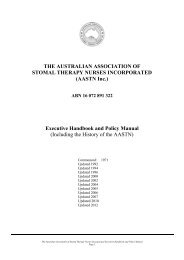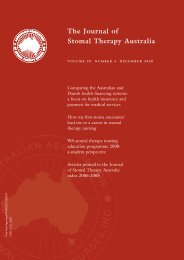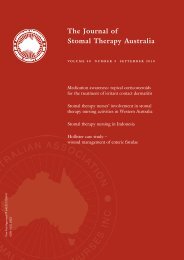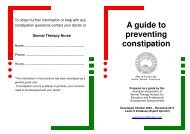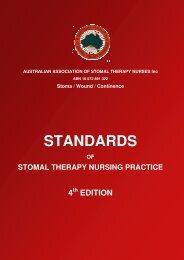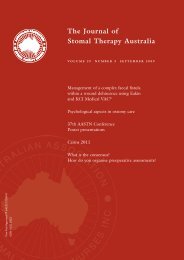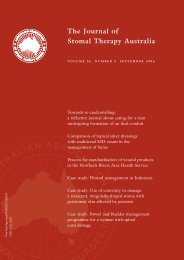The Journal of Stomal Therapy Australia - Australian Association of ...
The Journal of Stomal Therapy Australia - Australian Association of ...
The Journal of Stomal Therapy Australia - Australian Association of ...
You also want an ePaper? Increase the reach of your titles
YUMPU automatically turns print PDFs into web optimized ePapers that Google loves.
Risk management in stomal therapy practice<br />
Nola Polmear RN, RM, CHN, STN (Cred) Onc, BCN, BA, MSocSci • <strong>Stomal</strong> <strong>The</strong>rapy Department, Royal Hobart<br />
Hospital<br />
*This paper won the 2006-2007 Coloplast National Education Fund senior section<br />
Risk management was developed as an organisational strategy<br />
to deal with problems that might occur, particularly with regard<br />
to technology and the advent <strong>of</strong> the new millennium or ‘YK2’.<br />
In healthcare it is strongly aligned to the quality improvement<br />
cycle and quality outcomes for patients.<br />
<strong>The</strong> purpose <strong>of</strong> this paper is to explain what risk management is<br />
all about, using an example that stomal therapy nurses (STNs)<br />
are familiar with in their practice. That is, the risk that a patient<br />
will proceed to the operating theatre for an impending stoma<br />
without pre-operative siting. Siting is used to demonstrate how<br />
the risk management process can work, to demonstrate the<br />
fluidity <strong>of</strong> the process, and to act as an incentive to STNs to use<br />
risk management strategies in their practice.<br />
<strong>The</strong> risk management process has five tiers with communication<br />
and consultation being imperative to the process:<br />
1. Establishing the context <strong>of</strong> the risk – setting the scene.<br />
2. Identifying risks – what, when, where, why?<br />
3. Analysing risks – consequences and likelihood.<br />
4. Evaluating risks – comparing against standards and setting<br />
priorities.<br />
5. Treating risks – assessing, planning, implementing and<br />
evaluating.<br />
With final consideration given to ongoing monitor and review 1 .<br />
“Risk management … is a holistic management process applicable<br />
in all kinds <strong>of</strong> organisations, at all levels and to individuals.” 2<br />
Risk management may be applied to specific projects or to<br />
manage specifically recognised areas <strong>of</strong> risk. It is part <strong>of</strong> a process<br />
linked with quality improvement and should be continuous and<br />
ongoing. Clinical risk management<br />
...is based on the effective identification, analysis and management<br />
<strong>of</strong> potential and actual corporate, clinical and organisational risks<br />
and adverse events which are inherent in the provision <strong>of</strong> health care<br />
services to the community 3 .”<br />
<strong>The</strong> importance <strong>of</strong> risk management for STNs lies in the essence<br />
<strong>of</strong> their clinical practice, that is, the successful restoration <strong>of</strong><br />
patients to the community following ostomy surgery. STNs<br />
need to be conscientious in thought and effort in the review<br />
<strong>of</strong> their practice and the identification and management <strong>of</strong><br />
risks that may impinge on the successful rehabilitation <strong>of</strong> their<br />
patients. Imbued in risk management is the requirement to<br />
search for and deal with organisational problems, their causative<br />
or contributory factors and ways to appropriately reduce the<br />
likelihood <strong>of</strong> recurrence or consequences <strong>of</strong> the risk.<br />
We need to move beyond anecdotal clinical experience to be<br />
more explicit when bridging the gap between commonality <strong>of</strong><br />
experience and therapeutic interventions that are as accurate,<br />
as safe and as efficacious as possible 4 . <strong>The</strong> objective <strong>of</strong> the<br />
<strong>Australia</strong>n <strong>Association</strong> <strong>of</strong> <strong>Stomal</strong> <strong>The</strong>rapy Nurses Inc (AASTN)<br />
is that STNs “reflect the promotion <strong>of</strong> quality <strong>of</strong> care for a wide<br />
range <strong>of</strong> people with specific needs ” 5 .<br />
Standard 1 – Pr<strong>of</strong>essional Role and Self Development, states<br />
“<strong>The</strong> STN fulfils the obligation <strong>of</strong> the pr<strong>of</strong>essional role through:<br />
reflective practice, evaluation, practice based assessment tools,<br />
continuous pr<strong>of</strong>essional development and credentialling” 6 . <strong>The</strong><br />
concept is further reflected in the notion that STNs, as advanced<br />
registered nurses, are able to conceptualise their practice and<br />
“use theory, research evidence, observations and experience to<br />
think about practice in a way that considers factors other than<br />
the immediate event or circumstances” 4 . <strong>The</strong> risk management<br />
process is one... “<strong>of</strong> continuous improvement that is best<br />
embedded into existing practices” 7 .<br />
Establish the Context<br />
Establishing the context in which the risk management process is<br />
to take place entails a description <strong>of</strong> internal and external users<br />
<strong>of</strong> stomal therapy services, developing standards by which to<br />
judge the function and management process, and the structure<br />
on which the project is to be based 1 .<br />
Already established is the commitment <strong>of</strong> STNs to the provision<br />
<strong>of</strong> expert care and to function as advanced registered nurse<br />
practitioners. <strong>The</strong> AASTN Standards <strong>of</strong> <strong>Stomal</strong> <strong>The</strong>rapy Practice<br />
are the embodiment <strong>of</strong> the STN function and position within the<br />
nursing pr<strong>of</strong>ession and the healthcare system. STNs provide a<br />
service to their patients; internal to this agency are other nurses,<br />
medical staff, and allied healthcare pr<strong>of</strong>essionals; external to this<br />
agency are the patients and the wider community.<br />
An STN <strong>of</strong> many years experience, Pat Blackley states that<br />
satisfactory quality <strong>of</strong> life for stomal therapy patients is very<br />
much dependent on a new ostomate’s ability to “regain an<br />
acceptable style <strong>of</strong> living after discharge from hospital” 8 .<br />
Blackley draws our attention to the International Ostomy<br />
<strong>Association</strong> (IOA) Charter <strong>of</strong> Rights for people experiencing<br />
ostomy surgery. <strong>The</strong> Charter states “... all should have a right<br />
to a satisfactory quality <strong>of</strong> life after their surgery and that this<br />
Charter shall be realised in all the countries <strong>of</strong> the world” 8 .<br />
Both the AASTN Standards <strong>of</strong> <strong>Stomal</strong> <strong>The</strong>rapy Practice for<br />
STNs Practice and the IOA Charter <strong>of</strong> Rights for ostomates are<br />
a communication <strong>of</strong> the need to provide and extract expert care,<br />
and to seek out and prevent risks that may have an adverse<br />
16 JOURNAL OF STOMAL THERAPY AUSTRALIA 2007 27(3)



